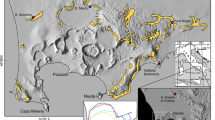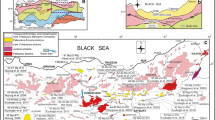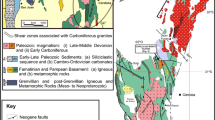Abstract
Most of the Al3+ entering the pyroxenes does so by substituting for tetrahedral Si4+. This creates a charge imbalance that requires the simultaneous entry of Cr3+, Ti4+, Fe3+ or Al3+ into octahedral sites. Cr3+, because of its high crystal field stabilisation energy (CFSE), is the most important of these elements to enter the early-formed pyrosenes but it is replaced by Ti4+ later in fractionation when the Cr3+ content of the melt becomes depleted. The dependence of Cr3+ and Ti4+ on charge balance controls their partition between coexisting pyroxenes and olivines. Ca-rich pyroxene which contains more Al3+ than Ca-poor pyroxene also has more Ti4+ and Cr3+ whereas olivine, which contains negligible Al3+, has low Cr3+ and Ti4+.
The Al3+ content of pyroxenes is influenced by changes in P, T, \(a_{{\text{SiO}}_{\text{2}} }\)and \(a_{{\text{Al}}_{\text{2}} {\text{O}}_{\text{3}} }\)of the magma and by the nature of the ion providing charge balance in the octahedral site. Of these \(a_{{\text{SiO}}_{\text{2}} }\)is dominant and variations in the Al3+ content of the Jimberlana pyroxenes correspond closely with the expected changes in the \(a_{{\text{SiO}}_{\text{2}} }\)of the melt.
The substitution of divalent ions, such as Mn2+ and Ni2+, in the pyroxene lattice is by replacement of Fe2+ or Mg2+ in the octahedral M 3 and M 2 sites and is therefore independent of charge balance. If there are no size restrictions, the principal factor to be considered is the CFSE the ion receives in octahedral co-ordination. Ni2+, which receives a high CFSE, partitions strongly between the early-formed pyroxenes and olivines and therefore becomes depleted in the magma with fractionation. Conversely Mn2+, which receives zero CFSE, concentrates in the magma with fractionation and becomes a more important substitute in the later-formed pyroxenes. Its geochemical behaviour is controlled by its size.
The narrow miscibility gap of the Jimberlana pyroxenes and the high En content of the Ca-poor pyroxenes at the bronzite pigeonite changeover suggest that these pyroxenes crystallised at a higher temperature than pyroxenes of comparable composition from other intrusions.
Similar content being viewed by others
References
Anastasiou, P., Seifert, F.: Solid solubility of Al2O3 in enstatite at high temperatures and 1–5 kb water pressure. Contr. Mineral. and Petrol. 34, 272–87 (1972)
Atkins, F. B.: Pyroxenes of the Bushveld intrusion, South Africa. J. Petrol. 10, 222–49 (1969)
Bhattacharji, S., Smith, C. H.: Flowage differentiation. Science 145, 150–3 (1964)
Boyd, F. R., Brown, G. M.: Electron-probe study of pyroxene exsolution. Min. Soc. Am. Spec. Publ. 2, 211–16 (1969)
Boyd, F. R., England, J. C.: Some effects of pressure on phase relations in the system MgO-Al2O3-SiO2. Carnegie Inst. Wash. Yearb. 62, 121–4 (1963)
Brown, G. M.: Pyroxenes from the early and middles stages of fractionation of the Skaergaard intrusion, East Greenland, Mineral. Mag. 31, 511–43 (1957)
Brown, G. M.: Mineralogy of basaltic rocks, in Basalts (vol. 1) (eds. H. H. Hess, Arie Poldervaart). New York: Wiley 1967
Brown, G. M.: Experimental studies on inversion relations in natural pigeonite pyroxenes. Carnegie Inst. Wash. Yraeb. 66, 347–53 (1968)
Brown, G. M., Vincent, E. A.: Pyroxenes from late stages of fractionation of the Skaergaard intrusion. East Greenland. J. Petrol. 4, 175–97 (1963)
Burns, R. G.: Mineralogical applications of crystal field theory. Cambridge: Cambridge Univ. Press 1970
Burns, R. G., Fyfe, W. S.: Site of preference energy and selective uptake of transition metal ions in a magma. Science 114, 1001–3 (1964)
Campbell, I. H.: The origin of heteradcumulate and adcumulate textures in the Jimberlana Norite. Geol. Mag. 105, 378–83 (1968)
Campbell, I. H.: Aspects of the petrology of the Jimberlana Layered Intrusion of Western Australia. Unpublished Ph. D. thesis, University of London (1973)
Campbell, I. H., MacCall, G. J. H., Tyrwhitt, D. S.: The Jimberlana Norite, Western AustraLia—a smaller analogue of the Great Dyke of Rhodesia. Geol. Mag. 107, 1–12 (1970)
Campbell, I. H., Nolan, J.: Origin of the Ca-poor minimum in Ca-rich pyroxenes from tholeiitic intrusions. Contr. Mineral. and Petrol. (in press) (1974)
Carmichael, I. S. E., Nicholls, J., Smith, A. L.: Silica activity in igneous rocks. Am. Mineralogist 55, 246–63 (1970)
Duchesne, J. C.: Pyroxene et olivines dans lc mrsi,j es Bjerkrem-Sogndal (Norvege meridonale). Contribution a l'etude de la serie anorthosite-mangerite. Rept. 24th Int. Geol. Congr. Section 2, 320–28 (1972)
Goldschmidt, V. M.: Geochemistry. Oxford: Claredon Press 1954
Gupta, A. K., Onuma, K., Yagi, K., Lidiak, E. G.: Effect of silica concentration on the diopside pyroxenes in the system diopside-CaTiAl2O6SiO2. Contr. Mineral. and Petrol. 41, 333–44 (1973)
Kushiro, I.: Si-Al relations in clinopyroxenes from igneous rocks. Am. J. Sci. 258, 548–54 (1960)
Le Bas, N. J.: The role of aluminium in igneous clinopyroxenes with relation to their parentage. Am. J. Sci. 260, 267–88 (1962)
Lindsley, D. H., Brown, G. M., Muir, I. D.: Conditions of the ferrowollastonite-ferrohedenbergite inversion in the Skaergaard Intrusion, East Greenland. In: J. J. Papike (ed.), Pyroxenes and amphiboles: Crystal chemistry and phase petrology. Min. Soc. Am. Spec. Paper 2, 193–201 (1969)
Mason, P. K., Frost, M. T., Reed, S. J. B.: B.M.-I.C.-N.P.L. computer program for calculating correlations in quantitative X-ray microanalysis. Nat. Phys. Lab. IMS Report I (1969)
Moore, A. C.: The mineralogy of the Gosse Pile Ultramafic Intrusion, Central Australia. II, Pyroxenes. J. Geol. Soc. Aust. 18, 243–58 (1971)
Naldrett, A. J., Bray, J. G., Gasparrini, E. L., Podolsky, T., Rucklidge, J. C.: Cryptic variation and the petrology of the sudbury Nickel Irruptive. Ec. Geol. 65, 122–55 (1970)
Pauling, L.: The nature of the chemical bond (1st and 3rd eds.). Cornell Univ. Press 1939 and 1960
Poldervaart, A., Hess, H. H.: Pyroxenes in the crystallisation of basaltic magmas. J. Geol. 59, 472–89 (1951)
Wager, L. R., Brown, G. M.: Layered igneous rocks. Edinburgh: Oliver and Boyd 1968
Walker, K. R., Ware, N. G., Lovering, J. F.: Compositional variations in the pyroxenes of the differentiated Palisades Sill, New Jersey. Bull. Geol. Soc. Am. 84, 89–110 (1973)
Whittaker, E. J. W., Muntus, R.: Ionic radii for use in geochemistry. Geochim. Cosmochim. Acta 34, 945–56 (1970)
Williams, R. J. P.: Deposition of trace elements in basic magma. Nature 184, 44 (1959)
Author information
Authors and Affiliations
Rights and permissions
About this article
Cite this article
Campbell, I.H., Borley, G.D. The geochemistry of pyroxenes from the lower layered series of the Jimberlana intrusion, Western Australia. Contrib. Mineral. and Petrol. 47, 281–297 (1974). https://doi.org/10.1007/BF00390151
Received:
Issue Date:
DOI: https://doi.org/10.1007/BF00390151




